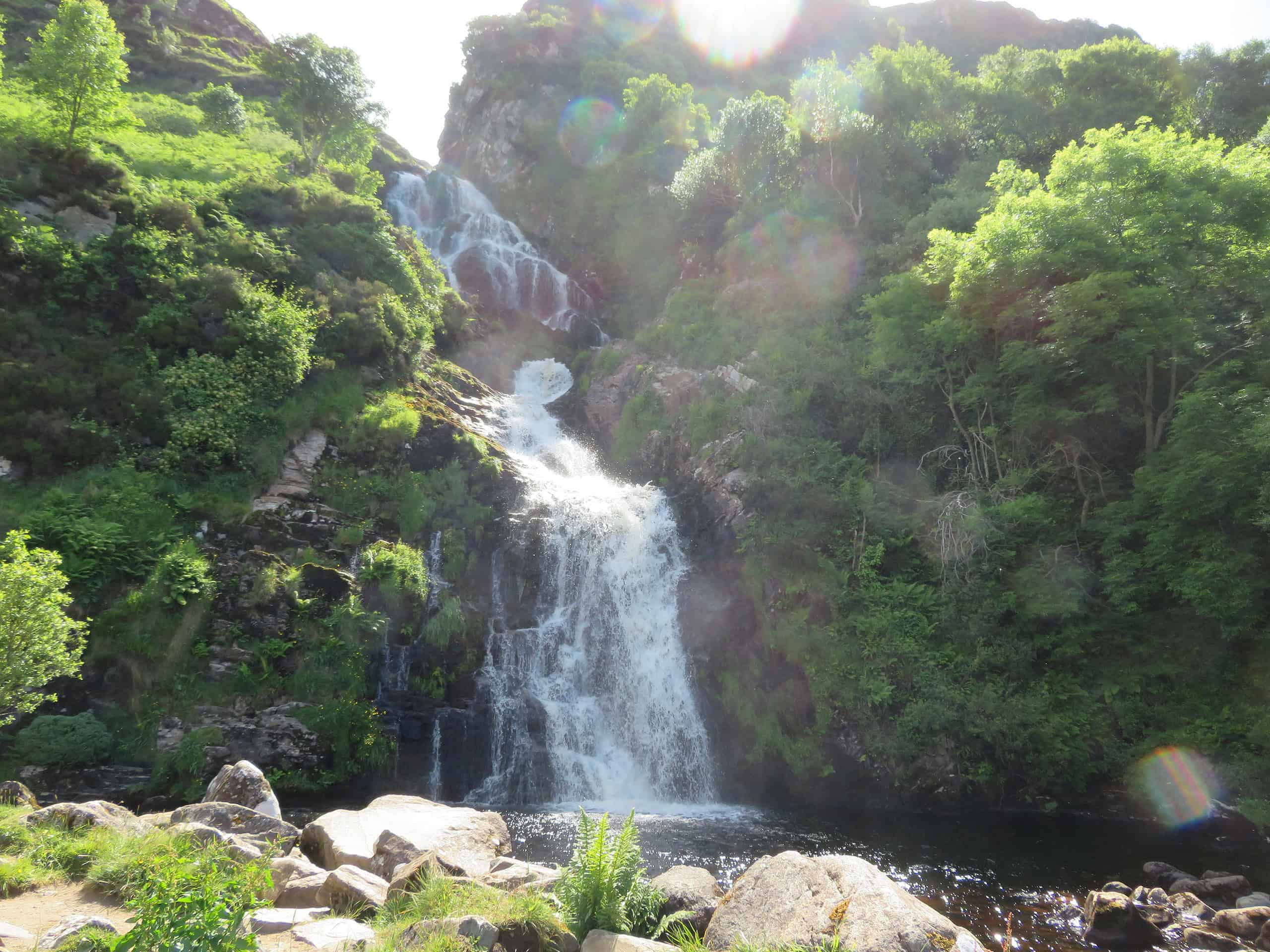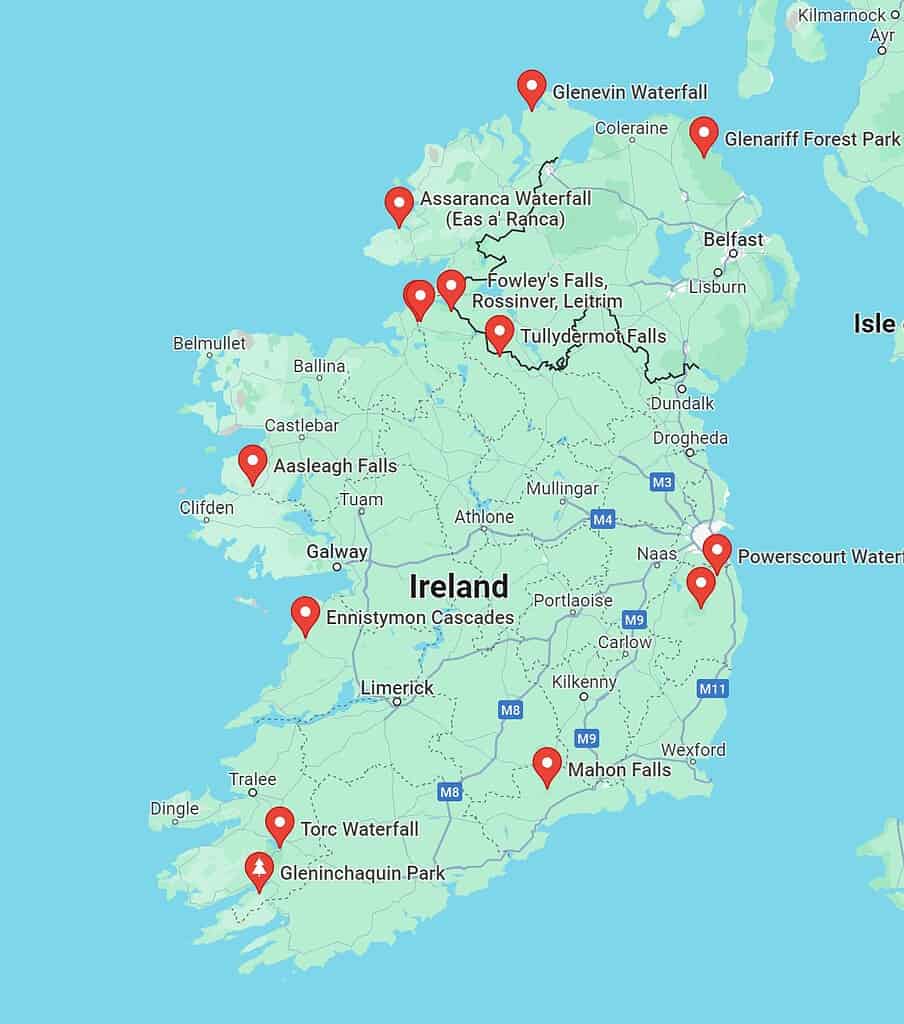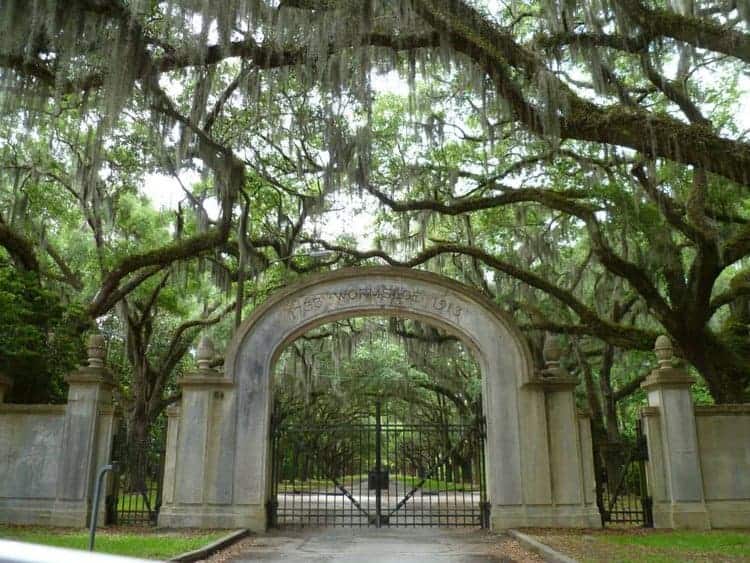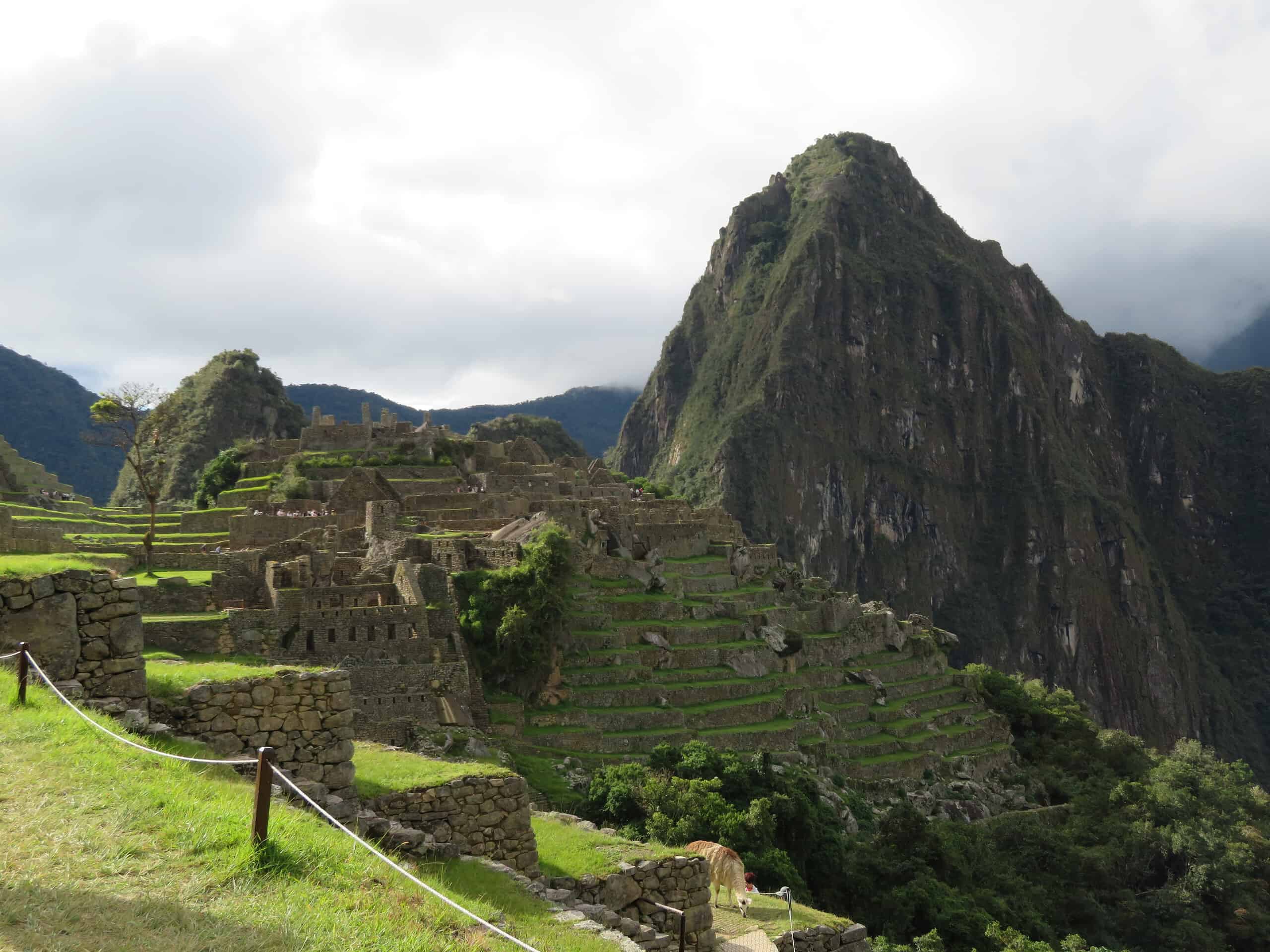The 13 Best Waterfalls in Ireland
While Ireland may not be as known for its waterfalls when compared to countries like Norway, it does offer some pretty spectacular ones. I was impressed by the options offered and loved exploring some of Ireland’s natural sights as a wheelchair user and consulted with fellow travelers for their favorites as well. Here are the top picks of the best waterfalls in Ireland that I think you should add to your next Ireland bucket list.
This post contains affiliate links. By clicking on a link and making a purchase, I earn a small commission at no cost to you.
Heading to Ireland Soon? Check out My Favorite Travel Resources!
Flights: Skyscanner
Travel Insurance: Insure My Trip
Hotels: Expedia
Tours and Activities: Viator
Best Waterfalls in Ireland Map
To use this interactive map of the best waterfalls in Ireland, simply click on the picture. It will take you to the original Google Map and you can zoom in, calculate routes, and more.
The Best Waterfalls in Ireland
One of the many reasons Ireland is worth visiting is its impressive waterfalls. While you may not associate waterfalls with Ireland, the country offers several options for you to visit during your next trip. Here are some of the best waterfalls in Ireland that you should check out.
1. Aasleagh Waterfall
Submitted by Jenny from Travel Ireland Today
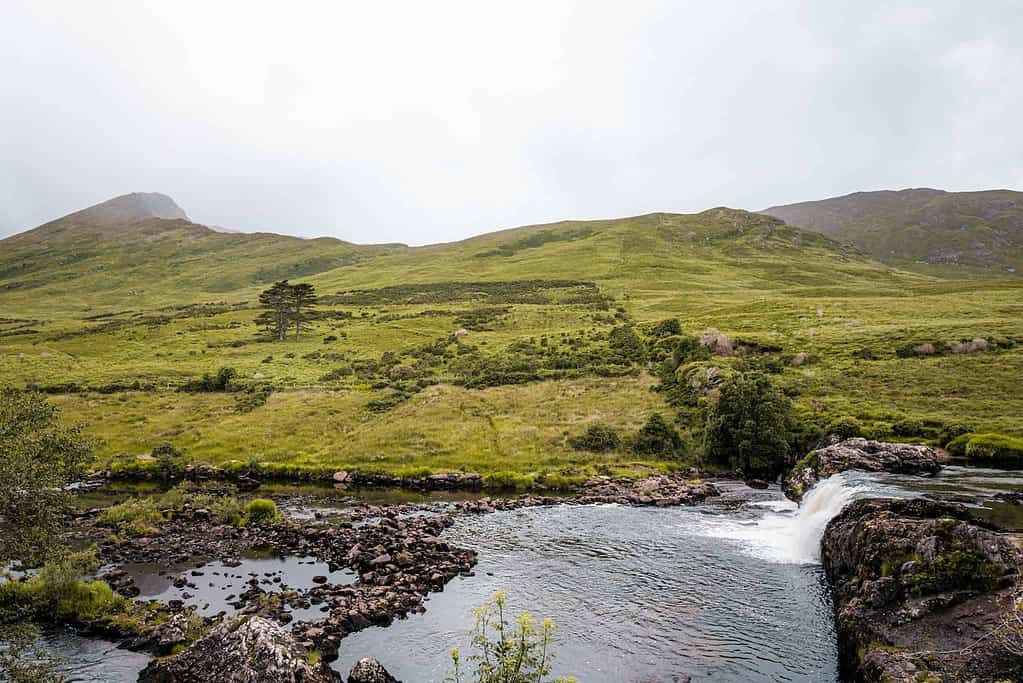
Aasleagh Waterfall is a hidden gem located just off the R335 near the Galway-Mayo border. This stunning waterfall is a must-visit for anyone exploring the west of Ireland.
While it is not particularly high, Aasleagh is quite a wide cascade, and if you’re lucky, you might even catch a glimpse of salmon leaping up the falls during the spawning season. During my visit, I didn’t see them spawn, but I was fortunate to see local researchers doing some salmon tracking and counting work.
The waterfall is part of the Erriff River, which flows into Killary Harbour, Ireland’s only fjord. Its exact location is Aasleagh Falls, Leenaun, County Galway, Ireland, H91 PY56.
Most visitors stop at Aasleagh Waterfall on the way to the Doo Lough Valley, a beautiful drive in Mayo with a dark history from the famine tragedy of 1849.
Additionally, the nearby village of Leenaun provides charming local shops and cozy cafes. Another notable attraction in the area is Killary Harbour, where you can take a boat tour and explore Ireland’s only fjord.
Accessibility
In terms of accessibility, the waterfall is visible from the road, but I wouldn’t recommend stopping there, as the main spot is on a bend with low visibility to cars. Instead, you can take a very well-maintained trail on the right side of the waterfall that leads to a viewpoint.
It is only a 5-minute walk and is wheelchair accessible. There is actually a one-car accessible car park right at the start of that trail, while other visitors can park at a larger parking area up the road.
2. Assaranca Waterfall
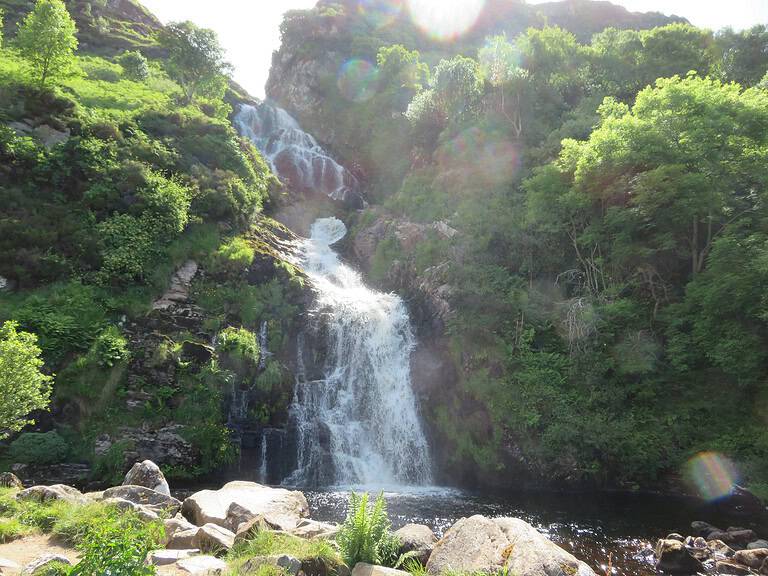
Located near the village of Ardara in County Donegal, Ireland, Assaranca Waterfall is a hidden gem that offers a picturesque and tranquil place to rest. Surrounded by lush greenery and rugged landscapes, it’s an ideal spot for nature lovers, photographers, and anyone seeking a peaceful retreat.
You could easily combine this stop with a visit to Slieve League Cliffs, which are only about 25 miles away. It’s a wonderful way to spend a nice day in Ireland and is an easy day trip from the town of Donegal.
Getting There
There are no tours that go here (the road is too narrow) so you will need your own vehicle.
From the town of Donegal, start by heading west on the N56 road towards Ardara. The journey takes about 45 minutes and offers scenic views of County Donegal’s rugged landscape.
Once you reach Ardara, follow the signs for the R261 road towards Maghera Beach. This part of the drive is particularly picturesque, taking you through charming countryside and coastal areas.
Accessibility
This waterfall can easily be seen from the road or the comfort of your own vehicle. However, if you wish to get out and explore, a small parking area with unmarked spots is available. After exiting your car, there is a homemade dirt ramp that goes onto a grassy area. The surface is a bit uneven but manageable.
3. Ennistymon Falls
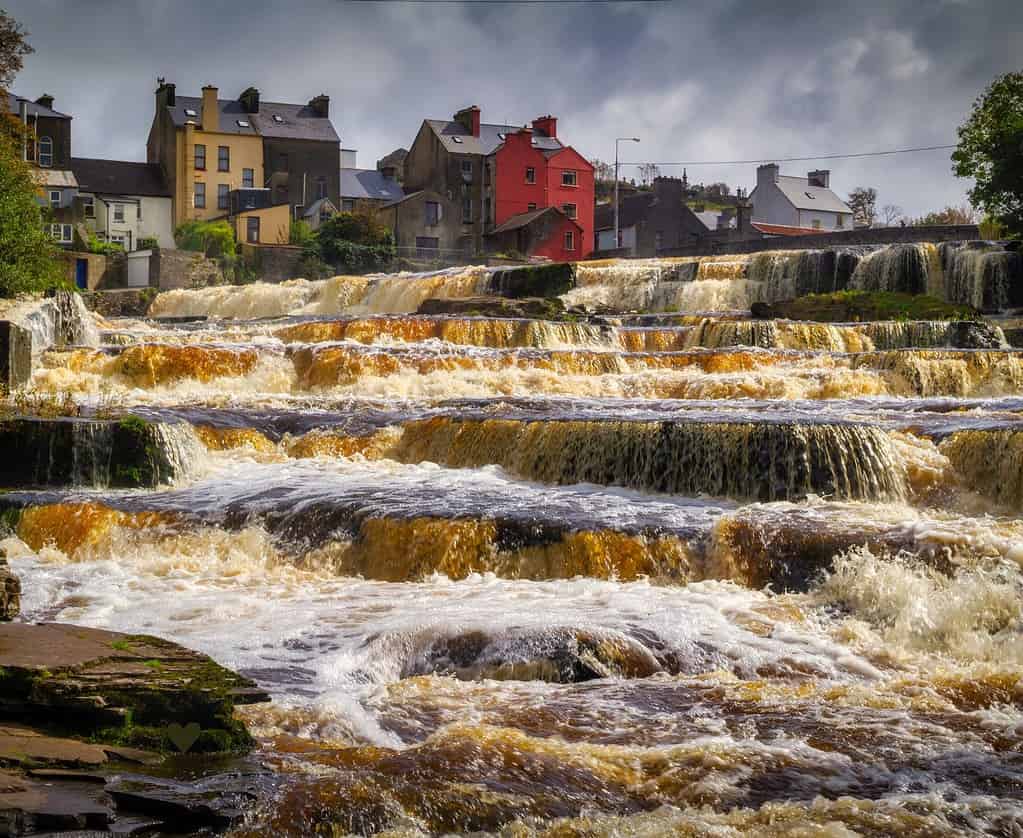
Just a 15-minute drive from the Cliffs of Moher is the charming town of Ennistymon. It is known for its market, colorful buildings, and of course the falls. These multi-tiered cascades are most impressive after a good rain and can be best seen from the bridge that crosses the river.
Most tourists skip over this small town, so if you’re looking to escape the crowds, this can be a wonderful base while you explore all that County Mayo has to offer. Other than the famous Cliffs of Moher, you can also visit Kilkee Cliffs, Doolin (known for its traditional music), and even a cave.
The Falls Hotel is an excellent choice for a chic place to stay. It’s an old manor house that was then added onto and offers comfort with a touch of luxury for anyone staying there.
➡️ Check availability and prices for your travel dates by clicking here.
Getting There
The cascades are centrally located in the town, making them accessible on foot. Begin your journey by heading towards the town center along Main Street, where you’ll find a variety of shops, cafes, and local landmarks. The cascades are situated just off Main Street, near the Ennistymon Bridge.
For parking, you can use the public car park located on Parliament Street. Alternatively, there are also other parking options available in the town center, but be mindful that they can fill up quickly
Accessibility
Once parked in one of the town’s central car parks, such as the one on Parliament Street, it’s a short, flat journey to the bridge by following signs to Main Street.
A paved path goes from the town to the cascades and along the river. If you want to take more of a roll/walk you can continue to take the trail past the Falls Hotel, where it becomes dirt and follows the river through the woods.
4. Fowley’s Falls
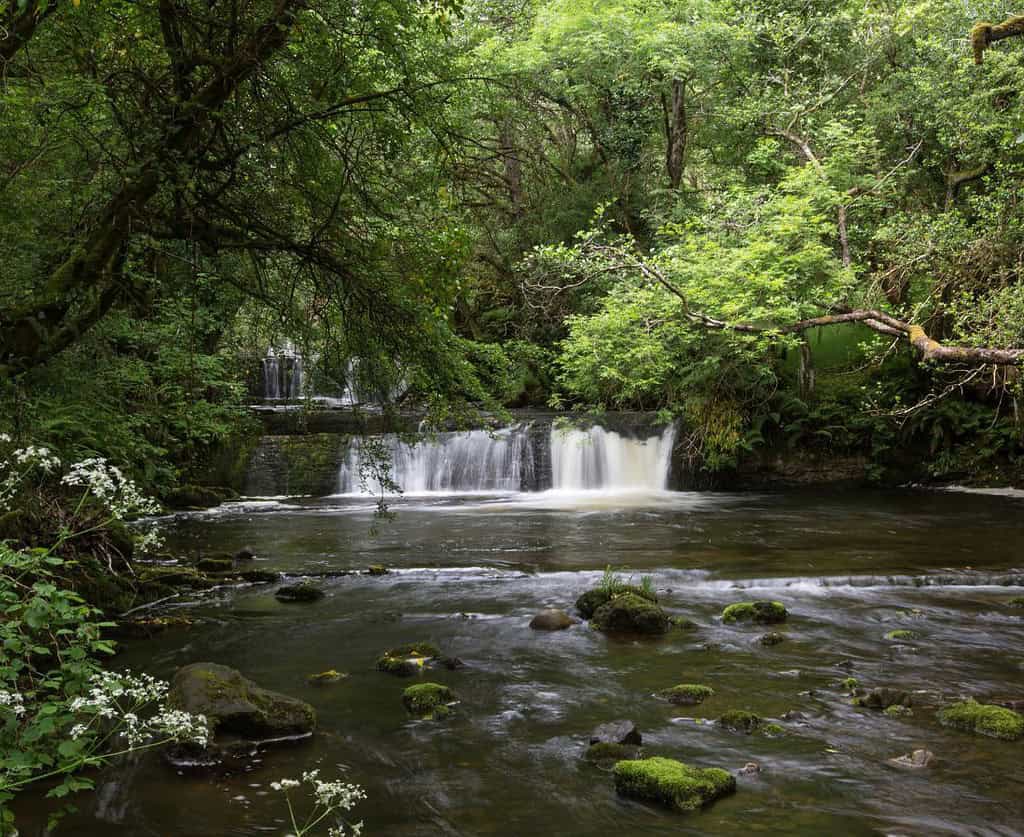
Fowley’s Falls, located near the village of Rossinver in County Leitrim, is a hidden gem that allows you to enjoy a relatively easy hike. This series of cascading waterfalls along the Glenaniff River creates a peaceful ambiance perfect for relaxation and exploration.
Once you’ve finished your hike, consider heading to nearby Marble Arch Caves Global Geopark (about a 30-minute drive). This UNESCO-designated geopark offers guided tours through spectacular limestone caves, showcasing stunning stalactites and stalagmites.
Getting There
From Rossinver, follow the signs for the falls, which are about a 10-minute drive away. There is a small car park at the entrance to the falls, but space can be limited, so arriving early is recommended.
The trail leading to the falls is well-marked and relatively easy to navigate, though it can be uneven and slippery in places, so sturdy footwear is advisable.
Accessibility
Unfortunately, this trail is not wheelchair accessible. There are several sections with stairs and the dirt path can be very narrow sometimes.
5. Glenariff Waterfall
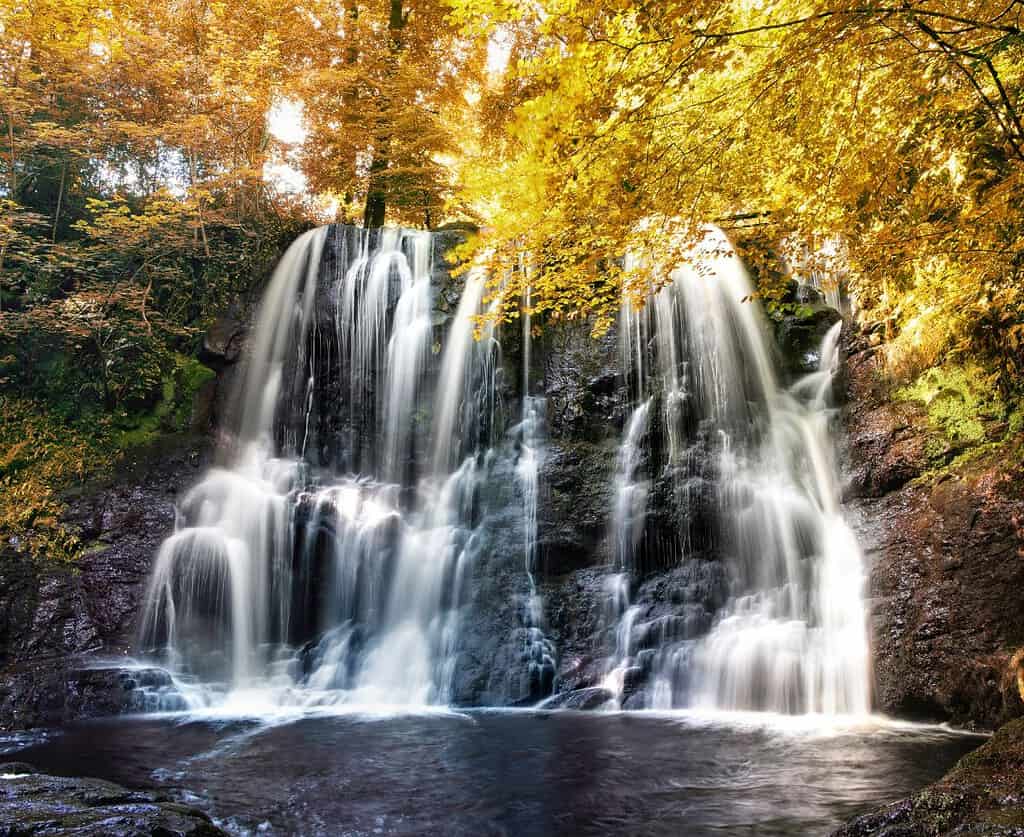
Glenariff Waterfall, located within Glenariff Forest Park in County Antrim, is often regarded as one of the best waterfalls in Ireland due to its breathtaking beauty.
Known as the “Queen of the Glens,” Glenariff boasts several stunning waterfalls surrounded by dramatic landscapes. The most famous of these falls, the Glenariff Waterfall, captivates visitors with its powerful flow and picturesque surroundings.
To access the falls,, you’ll want to take the Waterfall Walk. It’s a loop trail that takes around 1.5 to 2 hours to complete and includes some steep and uneven sections.
Getting There
From Belfast, it’s about a 1.5-hour drive north along the A2 Coastal Route, which offers scenic views of the Northern Irish coastline. Upon reaching Glenariff Forest Park, there is ample parking available near the visitor center. Then follow the signs to the Waterfall Walkway.
Accessibility
The waterfall walk is not wheelchair accessible due to stairs and steep grades. However, you can still see the falls if you are a wheelchair user or a person with mobility problems by driving to the Laragh Lodge Restaurant.
There is a flat entry into the restaurant and you can view the falls from various points inside. Additionally, behind the restaurant, there are compacted dirt trails that you can take to get closer to the falls. Although these trails may be steep at times so proceed with caution.
6. Glencar Waterfall
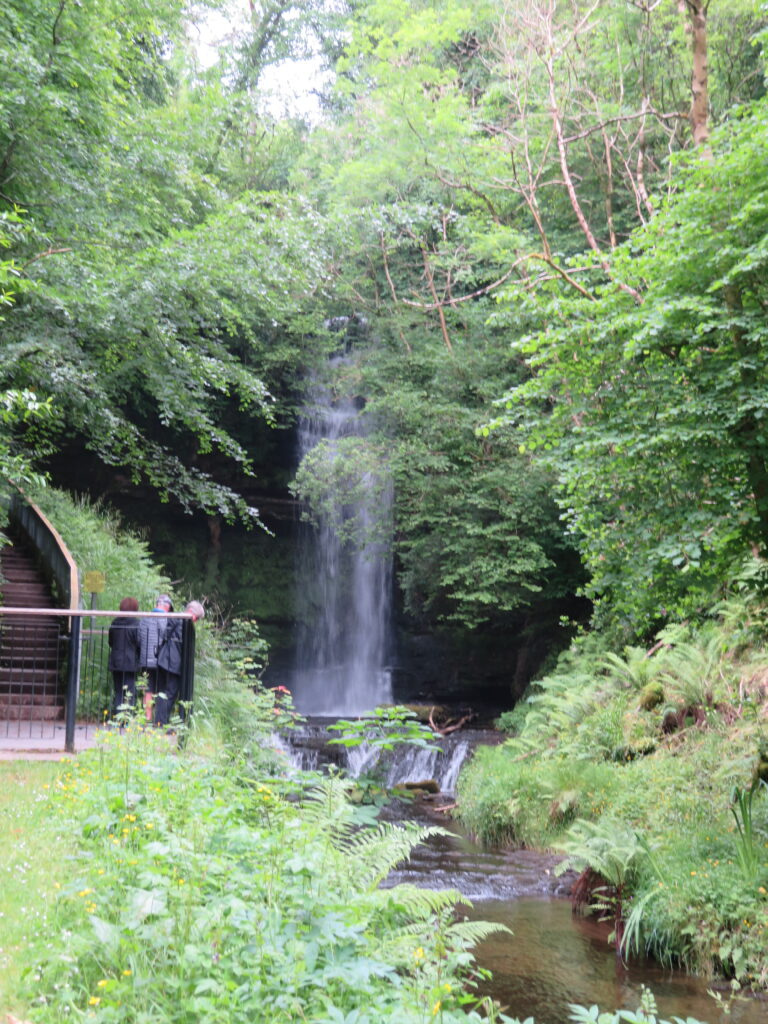
This waterfall, which inspired W.B. Yeats’ poem “The Stolen Child,” is known for its graceful 50-foot drop into a clear pool that then flows into a stream that has smaller cascades that parallel the wooded trail.
Yeats’ evocative description of the waterfall and its surroundings has immortalized Glencar in Irish literature, making it a pilgrimage site for literature enthusiasts and fans of Yeats’ work.
This connection to one of Ireland’s most celebrated poets adds a layer of cultural depth to the natural beauty of the site, as visitors can experience firsthand the inspiration behind Yeats’ poetic imagery.
Getting There
Drive about 10 kilometers north of Sligo town along the N15, then follow the signs for Glencar Lough. There is a convenient car park near the waterfall, making access easy.
Accessibility
A short, paved path leads from the car park to the falls. While there are some inclines along the way, I was able to easily manage them. There is a small overlook area of the falls before the path turns to stairs.
There are accessible bathrooms and a tea shed near the parking lot.
7. Glenevin Waterfall
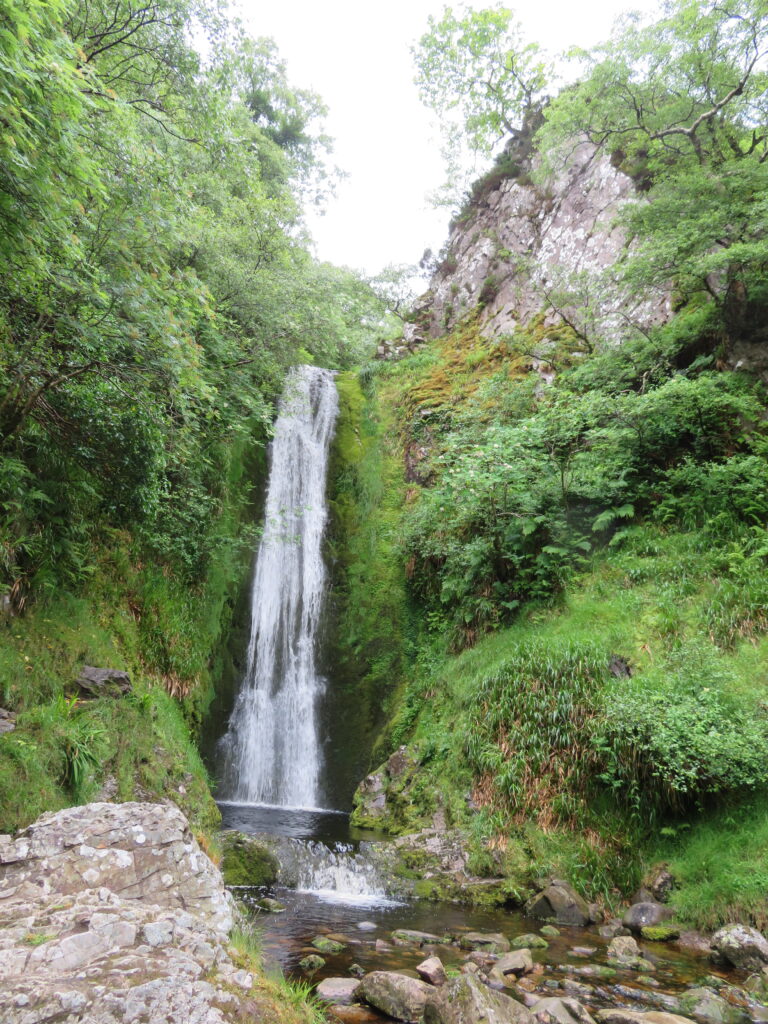
Tucked away in County Donegal, this waterfall stands out because of its impressive drop and the way it tumbles down over the rocks, creating a stunning display of cascading water.
Additionally, the trail to reach the falls is equally as lovely. You will wander through the woods and find a few fun surprises along the way, like the little fairy houses that dot the path. Nature lovers will also enjoy the natural flora and fauna that can be found here.
To round out your day consider adding either a trip to Ballyliffin Beach or driving the Inishowen Peninsula.
Ballyliffin Beach, which is about a 20-minute drive from the waterfall, offers a long stretch of sandy shoreline and breathtaking views of the Atlantic Ocean, making it perfect for a relaxing stroll or a day of seaside fun.
However, if you’re interested in exploring further, the rugged and scenic Inishowen Peninsula is also nearby, offering dramatic coastal landscapes and hiking opportunities. The scenic drive around the peninsula provides a chance to experience some of Donegal’s most striking natural beauty.
Getting There
You won’t find large tour buses here, so it’s best to have your own vehicle. If you are basing yourself in the town of Donegal, this is an easy day trip from there. This is what I chose to do when I stayed at Lough Eske Castle.
Start by heading north on the N15 road towards Ballybofey. From Ballybofey, take the N13 road heading west towards Clonmany. Once you reach Clonmany, follow the signs for the R238 road and then take the L-1221 road, which will lead you to the parking area near the trailhead for Glenevin Waterfall.
From the small car park, there is an approximately 2.5 kilometers (about 1.5 miles) round trip trail that takes you back to the falls.
Accessibility
The trail to the falls is made up of compacted dirt and gravel. There are some slight inclines along the way, but nothing my small powered wheelchair couldn’t handle.
8. Gleninchaquin Waterfall
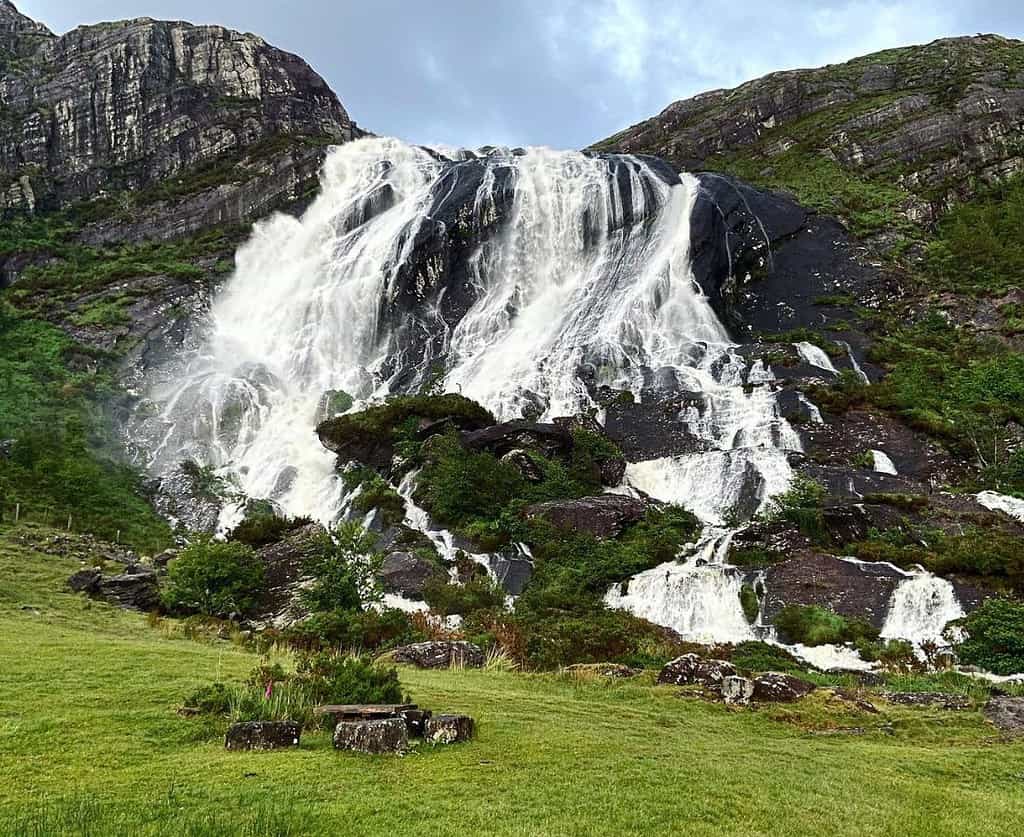
This stunning waterfall cascades down a rugged mountainside into a picturesque valley, creating a breathtaking scene that epitomizes the natural beauty of Ireland. The surrounding Gleninchaquin Park offers a peaceful and serene environment, perfect for those looking to escape the hustle and bustle of tourist-heavy areas and immerse themselves in nature.
Furthermore, one of the main reasons Gleninchaquin Waterfall stands out is its variety of activities available. The park provides several well-maintained walking trails, ranging from easy strolls to more challenging hikes, each offering unique views of the waterfall and the surrounding landscape.
Getting There
The best route to reach Gleninchaquin Waterfall is by car, as it is situated in a remote area that is not well-served by public transportation. From Kenmare, a charming town nearby, it’s a scenic 20-kilometer drive that takes about 40 minutes. The route offers stunning views of the Irish countryside, making the journey itself a memorable experience. Once at the park, ample parking is available.
Accessibility
Visitors with mobility problems are allowed to drive closer to the falls to avoid walking. When you enter the park, just notify the attendant of your needs and they will direct you from there.
There is also an accessible sensory garden within the park.
9. Mahon Falls
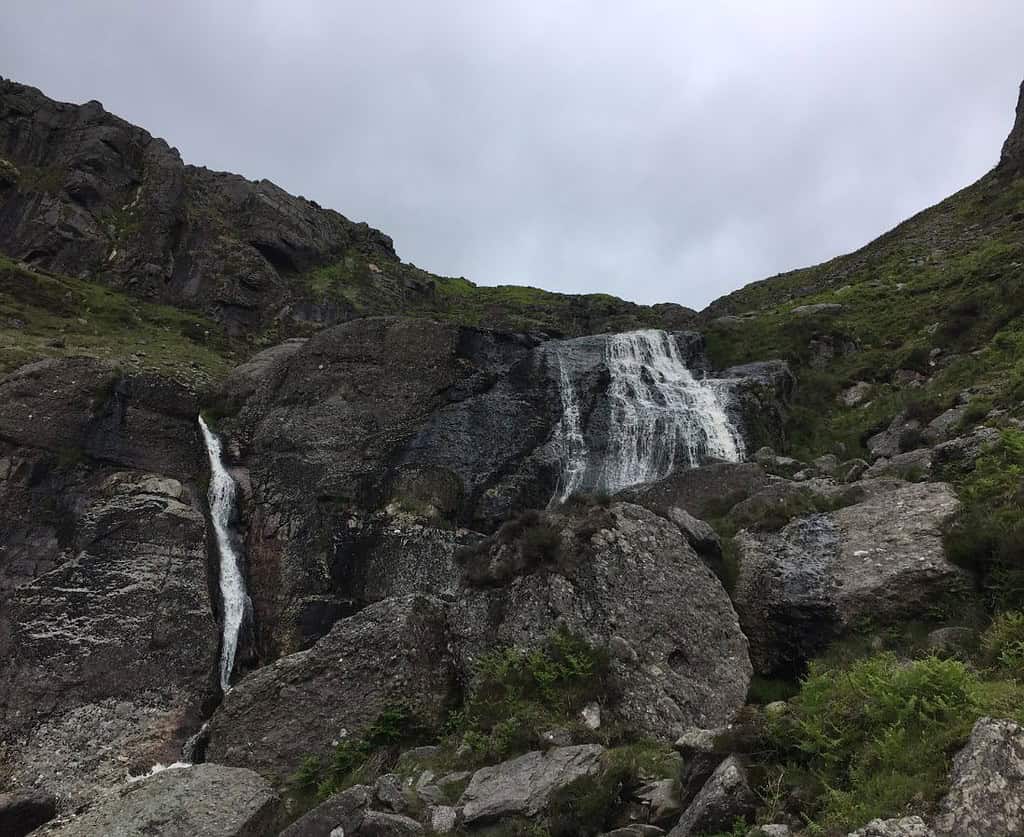
Mahon Falls is located in the picturesque Comeragh Mountains in County Waterford. It is a must-visit destination for both first-time travelers and returning visitors seeking to get out into the beautiful countryside. At 80 meters tall, this impressive waterfall is not to be missed.
For those seeking additional adventures, the Comeragh Mountains offer numerous hiking trails with varying levels of difficulty, providing opportunities to explore more of the region. Other nearby attractions include the picturesque village of Lemybrien, where visitors can enjoy traditional Irish hospitality and local cuisine.
Getting There
To reach Mahon Falls, travelers can drive from Waterford City, which is about a 45-minute journey by car. The most scenic route is via the N25 and R676, offering breathtaking views of the countryside along the way. There is a car park conveniently located near the falls, from which a well-marked trail leads visitors on a gentle, 2.4-kilometer round-trip hike to the base of the waterfall.
Accessibility
There’s a compressed gravel trail from the car park to the waterfall with lovely views along the way. The track is gravelly and has a lot of ups & downs, but a power wheelchair should be able to manage the path. However, if you are using a manual wheelchair, you may need some assistance.
The trail accessibility ends about 200m from the waterfall with a non-accessible stream crossing.

10. Poulanass Waterfall
Submitted by Amber of Amber Everywhere
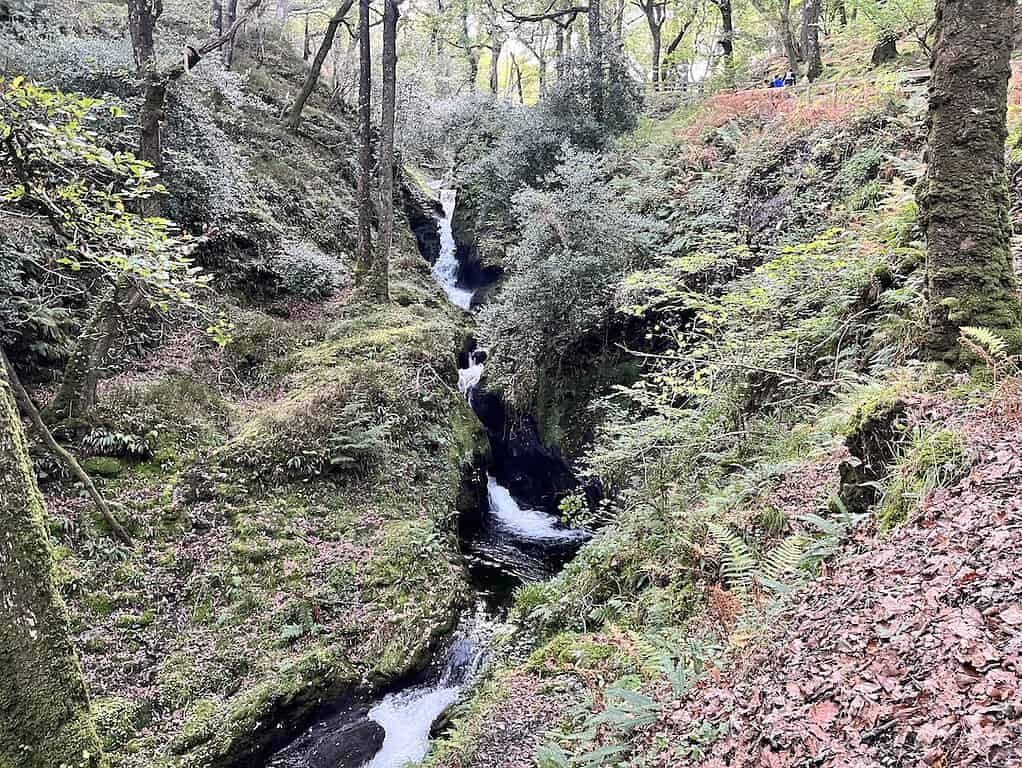
About an hour outside of Dublin and deep in the Wicklow Mountains is Glendalough, one of the most peaceful places to visit in Ireland. While there, you can visit a set of monastic ruins, the serene Glendalough Upper Lake, and, of course, the Poulanass Waterfall.
The waterfall’s name, ‘Poulanass’ comes from the Irish ‘Poll an Eas’ meaning ‘hole of the waterfall.’ Poulanass is set right along the popular Spinc Trail that winds up and around the Upper Lake.
The Poulanass Waterfall is one of the best waterfalls in Ireland because it winds through the mossy, dense underbrush of the Wicklow Mountains and you can walk right alongside it on the trail.
Getting There
There are two options for getting to this waterfall. First, you can rent a car and drive there. This will allow you to take your time and then continue to drive through the picturesque Sally Gap or stop for a pint at the Wicklow Heather Pub.
Alternatively, you can also take a tour of the Wicklow Mountains from Dublin.
Once at the Upper Lake car park, you’ll need to hike for 20-30 minutes to reach this waterfall’s most popular lookout point. The waterfall is not visible from the car park or road.
Accessibility
Unfortunately, the waterfall is not wheelchair accessible as the hike requires you to navigate stairs and steep trails. Likewise, the monastic ruins are not wheelchair accessible.
However, a portion of the trail along the Upper Lake is accessible and perfect for a nature walk. From the trail, you can see Saint Kevin’s Bed, a famous cave where Saint Kevin is said to have lived during his years of hermitage.
11. Powerscourt Waterfall
Submitted by Bev & Shams of bevandshams.com
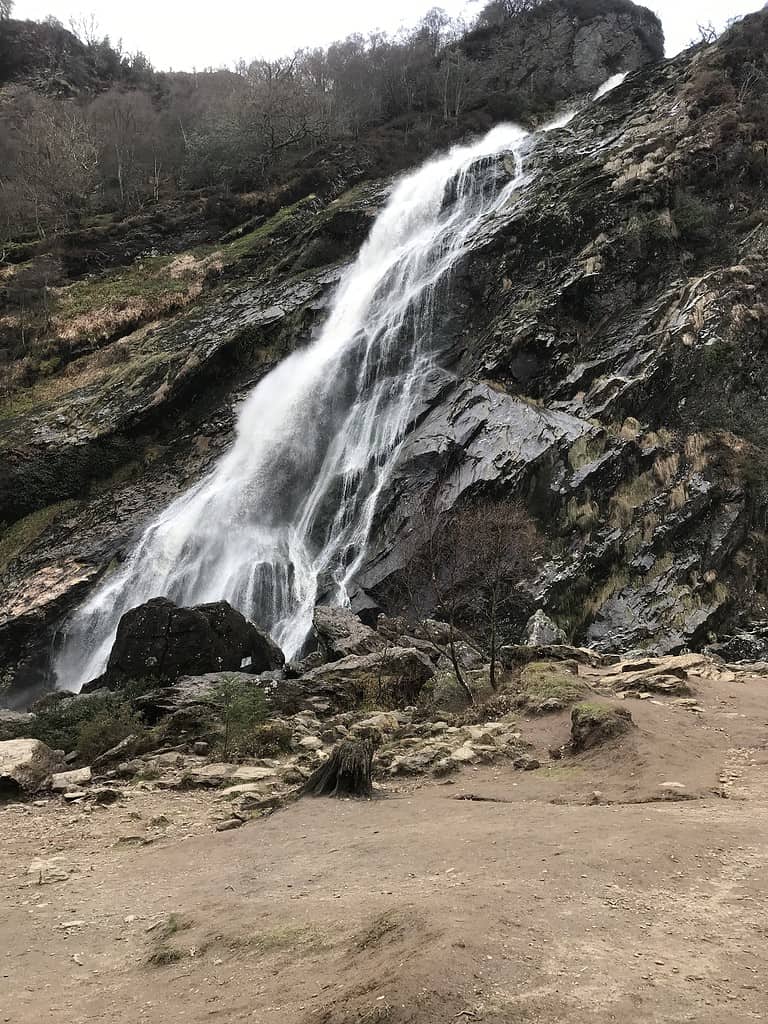
What makes Powerscourt Waterfall one of the best waterfalls in Ireland is the peace and tranquil location, with far fewer crowds. You can watch as the water cascades down the waterfall into a serene pool below, before trickling off into a small stream and relax to the sounds. It can feel very zen.
Although this isn’t one of the largest waterfalls in the world, it is one of the tallest in Ireland at just 121 meters and is part of Powerscourt Estate, House and Gardens.
After visiting the falls, make sure to check out the famous gardens at Powerscourt Estate, which were recently voted among the top 10 in the world. Additionally, you can enjoy the many trails on the estate or even spend the night and participate in a falconry experience.
➡️Check pricing and availability for a stay at the Powerscourt Estate Hotel by clicking here.
We would recommend spending at least four days road-tripping around Co. Wicklow, where you can also explore Powerscourt Estate, House and Gardens, hike to the top of the Great Sugar Loaf, visit Glendalough Monastic Site and Glendalough Upper and Lower Lakes. Here you’ll see
plenty of smaller waterfalls compared to the much larger Powerscourt Waterfall.
Getting There
Ideally, you’ll need a car to get you to this remote location. You can either hire a vehicle like we did when took a four-day road trip around Co. Wicklow, or book a taxi, but this could be an expensive option.
The drive from Powerscourt Estate, House, and Gardens should take around 10 minutes depending on traffic. At the entrance gates of Powerscourt Waterfall you’ll follow a road down to the car park.
Here you’ll find a cafe with toilets and accessible toilets and a children’s play area.
Accessibility
The trail down to the waterfalls is accessible via a fully maintained road, which leads off to a grassy picnic and BBQ area. This is the ideal spot to relax and watch the water tumble over the rocks. Accessible bathrooms are also available.
There are some short walking routes, if you wish to explore the fauna and flora around the falls.
12. Sruth in Agaidh An Ard (Devil’s Chimney)
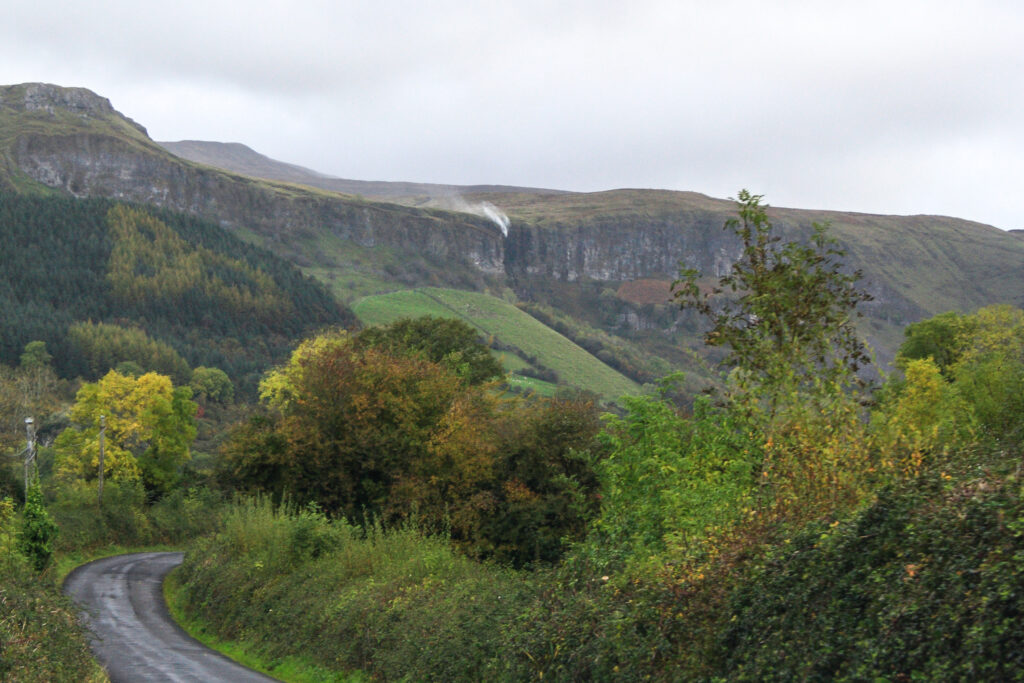
This 150-meter waterfall is an impressive sight to behold and is located near the Glencar Waterfall which was mentioned earlier in this post. It offers a lovely 1.2 km wooded hike along a looped route where visitors can get a closer view of the falls and immerse themselves in nature. Expect to spend about an hour on the trail.
While tourists may know the sight as Devil’s Chimney, the original Irish name is Sruth in Agaidh An Ard which means “stream against the height”. The falls get this name because the wind can blow so hard that the water actually seems to flow upwards.
However, it should be noted that this magnificent waterfall is not present year-round. When there has been a dry spell, you may not even see the falls at all. Therefore, it is best to visit after heavy rain. Just be mindful when doing so as the path can be slippery.
Getting There
From Sligo, take the N16 Manorhamilton Road and turn left at the Glencar Waterfall sign. There is a small car park that can accommodate 5-8 cars but can be easy to miss, so keep an eye out for it.
After parking your vehicle, enter the kissing gate and continue on the trail following the red arrows.
Accessibility
Most of the waterfall can be seen from the car park, so you can enjoy the view of the falls no matter what your ability. However, the trail itself is not wheelchair accessible. It has steep sections and stairs to navigate. Additionally, the path narrows quite a bit near the waterfall.
13. Torc Waterfall
Submitted by Imee Magbag of Ireland Travel Guides
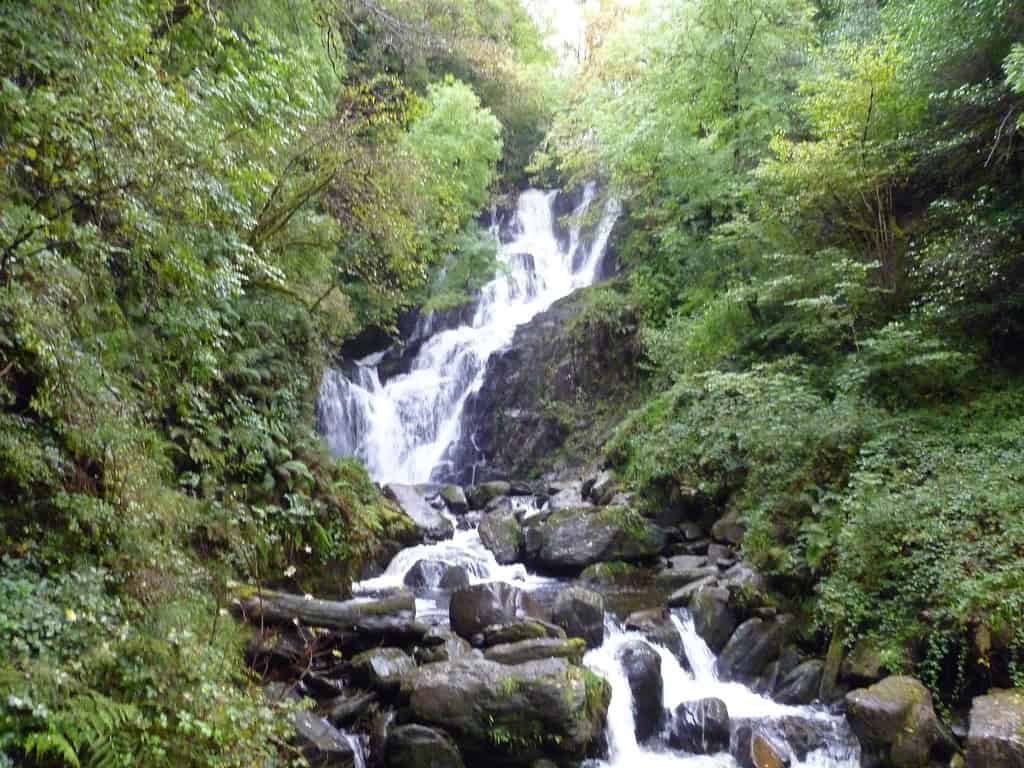
Torc Waterfall is a 20-meter-high waterfall and is considered to be one of the best things to do in Killarney due to it be surrounded by the stunning landscapes of Killarney National Park.
The word Torc” translates to “wild boar” in Irish and according to local legend, a magical boar was slain by the hero Fionn MacCumhaill on the very spot where the waterfall now stands.
While in this iconic national park, you may also want to learn about the history of Mucross Abbey, a historic Franciscan monastery founded in the 15th century. It’s a serene spot with a well-preserved cloister and ancient yew tree.
Alternatively, you could participate in a guided tour, bicycle through the park’s many trails or go horseback riding.
Getting There
From the Muckross House, head south on N71 to reach the car park. However, if you would prefer to hike, you can also reach the falls by taking the Kerry Way or the (much shorter) Muckross Lake Loop.
The base of Torc Waterfall is only a five-minute walk from the car park through a lush, mossy forest.
Accessibility
There are steps leading up to various viewpoints around the waterfall, so wheelchair accessibility is limited to the lower sections near the car park. The area has benches and viewing platforms, allowing for breaks and photo opportunities.
14. Tullydermot Falls (Bonus)
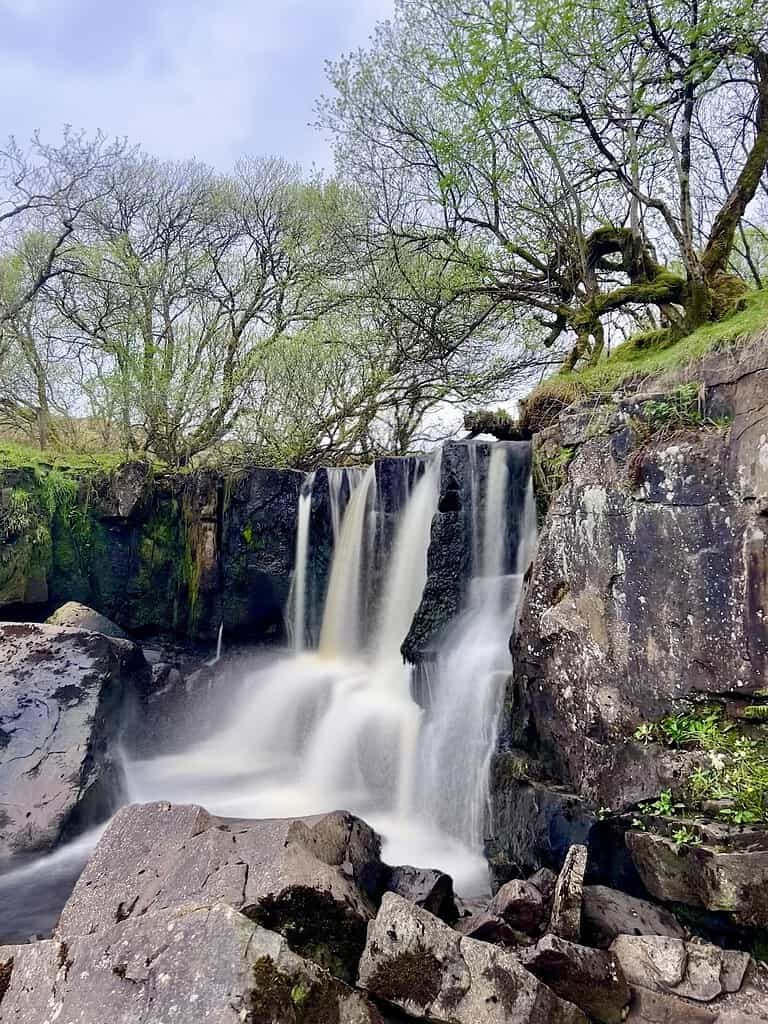
Tullydermot Falls, located in the picturesque Cuilcagh Mountains of County Cavan, is a hidden gem that offers nature lovers a serene and breathtaking experience. This stunning waterfall cascades over a series of rocky outcrops, creating a mesmerizing display of natural beauty that is both tranquil and invigorating.
One of the reasons Tullydermot Falls stands out as one of the best waterfalls to visit in Ireland is its relatively untouched and pristine environment. Unlike some of the more famous waterfalls in the country, Tullydermot Falls is less crowded, allowing you to fully immerse yourself in the serene surroundings.
Getting There
The best way to reach the falls is by car, as public transportation options are limited. From Dublin, it’s approximately a two-hour drive. Head towards Enniskillen and then follow signs for Swanlinbar. The falls are located just a short drive from the village of Swanlinbar, with clear signposts guiding you to the site. There is a small parking area near the falls, and from there, a short walk will lead you to the viewing point.
Accessibility
There is a short trail from the parking area to the falls that is dirt and compacted gravel. While the initial part of the trail can be quite steep, it eventually becomes more of a gentle slope.
There are no stairs along the trail so it is labeled as accessible, but you may want some assistance with the beginning of the trail during the steep portion as it may be challenging otherwise.
Waterfall FAQs
What is the Tallest Waterfall in Ireland?
Two waterfalls often battle over this title so there can be a little bit of a debate. However, at 150 meters high, Sruth in Agaidh An Ard is technically the tallest waterfall in Ireland.
Although, there are times when this waterfall isn’t visible or dries up completely (usually in the summer). That is when Powerscourt Waterfall claims to be the tallest waterfall in Ireland at 121 meters high.
What is the Most Beautiful Waterfall in Ireland?
I hope that this post has shown you that there are a variety of beautiful waterfalls in Ireland. Deciding the most beautiful is hard because everyone has different ways to define that.
Some think the taller the better, while others enjoy wider falls. Personally, I think each waterfall on this list has something unique and wonderful to offer. Why not visit them all and decide for yourself which one you like the best?
What is the Most Famous Waterfall in Ireland?
The most famous waterfall in Ireland is probably Torc Waterfall. It’s one of the most popular ones to visit as it’s located near Killarney and the Ring of Kerry.
Two other famous waterfalls in Ireland are Powerscourt Waterfall (due to its location on the estate) and Sruth in Agaidh An Ard (Devil’s Chimney) because of its appearance to blow upwards when the wind is right.
When to Visit Ireland
I like to visit Ireland in the shoulder seasons (March to early June and September to October). I find the weather is still fairly good, the crowds are fewer, and I can usually find cheaper airfare.
My previous trips were both in October and June. While there can still be rain (it is Ireland after all), you can usually be comfortable sightseeing in some light layers and a jacket.
Furthermore, if you want to see the waterfalls at their peak, then visit in the rainier months of March, September, October, and November.
How Long to Spend in Ireland
I recommend spending at least 10 days in Ireland if you can. This gives you an opportunity to see many of the popular sights at a reasonable pace. However, 7 days in Ireland is also doable.
However, if you have time for a longer trip, spending 3 weeks in Ireland is absolutely delightful. It allows flexibility in your itinerary and to go at a slower pace so you can really enjoy the sights.
Overall, I really don’t recommend spending only 3 days in Ireland as you only have time for one location and don’t really get to embrace the local lifestyle.
Recap on the Best Waterfalls in Ireland
I hope that his post on the best waterfalls in Ireland has helped you find some new sights and hidden gems you may not have known about. Be sure to add some of these fantastic falls to your next Ireland itinerary for a chance to connect with nature during your next trip.

